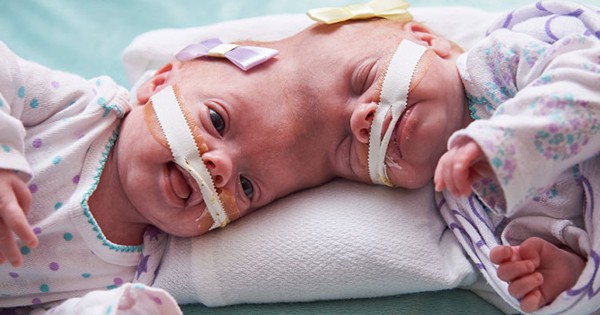Abby and Erin Delaney were born in CHOP’s Garbose Family Special Deʟɪᴠᴇʀy Unit, after being closely monitored by the Hospital’ Center For Fetal Diagnosis & Treatment. The Delaney twins were connected at the top of their heads, a condition called craniopagus, the least common type of conjoined twins. The girls were the 23rd pair of conjoined twins separated at Children’s Hospital of Philadelphia (CHOP), the first craniopagus pair.
Yes, they’re conjoined, but there are times where when one of them will be crying and the other one’s completely fast asleep, and the one that’s crying I like to have to remind myself, you can’t just pick her up.

As a parent, it doesn’t matter what the issue with them or what they do or what they look like, you are going to love that child no matter what. Kids are connected by the head, they can be connected in a couple of different ways. One is by if they’re connected at the front or the back; one is if they’re connected and they just share skin, which is really, really rare, we almost never see that. But in this case, what they share is bone and then the coverings of the brain, the dura. So in these kids, it looks like they just share the skull and the coverings, but they also share this important vein that goes down the middle called the sagittal sinus, which is where about 20 percent of your cardiac output goes through.

Surgery to separate conjoined twins involves many steps. Over their first 10 months, the girls underwent a series of surgeries, including the placement of expanders to stretch their skin. It’s a very extensive team of people, this is the kind of thing that they get together beforehand and they practice so that the day of surgery, everybody has a very well-defined role; everybody knows what their role is. So it’s like choreographed dance moves.

So it’s multiple surgeries over several months. Really young babies are at their most regenerative the earlier on they are in life. The separation of conjoined twins is a very complex surgery followed by a long and complicated recovery. Co-led by neurosᴜʀɢᴇᴏɴ Gregory Heuer, MD, Ph.D., and plastic surgeon Jesse Taylor, MD, a multidisciplinary team of approximately 30 members, including physicians, nurses and other medical staff from neurosurgery, plastic and reconstructive surgery, and anesthesiology, participated in the separation surgery, which lasted about 11 hours.

It was a lengthy operation and lots of ups and downs, emotionally and physically both for their and for all the team members and for the girls themselves.

Formerly conjoined twins require urgent, specialist care after separation. As the separated children recovered from surgery, their sᴜʀɢᴇᴏɴs, nutritionists, developmental pediatricians, and other specialists monitored them closely to ensure that they were receiving the finest clinical care possible to help them flourish and grow. They also received intensive therapy from a team of speech, occupational and physical therapists. Over the next few years, the girls will require additional surgeries to replace missing bone in their skulls and to minimize scaring.

To say the least, the two months following surgery have been a rollercoaster. For what they’ve been through, they’re such cheerful, joyful little kids. They’ve never lived anywhere other than the Hospital and are still happy; they’re not ᴛᴇʀʀɪfɪᴇᴅ of people. The girls have been doing well in their therapies and a slowly but surely still progressing. It’s just amazing to see that they’re so brave through all of this.

The girls’ journey is far from over. And it feels a lot of times like we’re about to go home, we’re almost done, but I have to keep reminding myself we still have a lot of obstacles to overcome. The biggest thing is right now they don’t have any skulls on the top of their heads.

When they first found out about them, they really didn’t know what to expect, but in coming here, it’s been a family. That really is a place where miracles happen.


